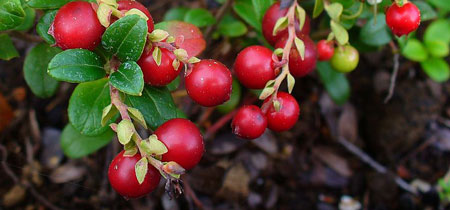Sarah Browning, Nebraska Extension Educator

Ligonberry is a relative of cranberry and blueberry in the genus Vaccinium.
Have you ever heard of a whortleberry? Or cowberry? If not, then maybe you've heard of lingonberry, a lesser-known, in the United States at least, relative of blueberry and cranberry, from the genus Vaccinium. But if you're of Swedish descent, or any of the Nordic or Baltic countries of northern Europe, then lingonberries may be an essential part of your holiday cooking.
Lingonberry's wide native distribution across Europe's northern hemisphere has led to a dizzying collection of common names, including cowberry, foxberry, wolf berry, whortleberry, moss cranberry, dry ground cranberry, rock cranberries, mountain cranberry, mountain bilberry, partridgeberry, whimberry, red whortleberry, alpine cranberry or simply lingon or lingen.
Botanically it's known as Vaccinium vitis-idaea, and is now also grown in North America from Massachusetts to Labrabor, the Pacific Northwest, Alaska and British Columbia. Unfortunately, lingonberry does not grow well in Nebraska gardens, since it does not like the high pH clay soil, hot summers or dry conditions that typify the Great Plains, but we can still enjoy the fruit of others harvest.
Growing Lingonberries
Plants grow best in moist, peaty, acidic soil in full sun, and are small, ranging from 4 to 12 inches tall, with dark green, evergreen foliage. In winter the foliage turns a metallic mahogany color. Small white or pink flowers are produced in early summer, followed by dark red fruits similar in appearance to cranberries but smaller. Fruit is harvested from August through September, heralding the beginning of fall.
Nutritional Value
Lingonberries have a very high level of antioxidants, vitamin A, C, B1, B2, B3, potassium, calcium, magnesium and phosphorus. Definitely a superfood! They also store well, similar to cranberries. Fresh lingonberries can be refrigerated for 8-12 weeks, or frozen and kept for several years.
They work well as an accompaniment to wild poultry, turkey, chicken, game, pork, ham or cheese. Traditionally, Swedish meatballs are served with lingonberry sauce.
Cooking with Lingonberries
Right off the bush, lingonberries have a tart, acidic flavor so are commonly cooked and sweetened into jam, syrup or baked goods before being eaten. They can be substituted in any recipe that calls for cranberries or blueberries.
However, if you live in a location where fresh lingonberries are available, they can be prepared in a variety of ways. One of the simplest preparations is vattenlingon, or water lingonberries. Simply fill clean jars with fresh, washed berries and pour boiling water over to cover them. Cap the jars, and refrigerate. Later, a small amount of the liquid can be mixed with ginger ale for a refreshing drink. Or the berries can later be used to make preserves or sauce.
Use raw lingonberries and sugar to make a no-cook preserve. Start with 2 pounds of fresh, washed lingonberries and crush them in a bowl with potato masher. Or give the berries a quick spin in the food processor, but leave them fairly chunky. Next, add 1 ½ to 3 cups of sugar depending on your taste. Start with less sugar, and add more until you're satisfied with the flavor. Stir until all the sugar has melted. Bottle and refrigerate or freeze.
Or make a cooked lingonberry sauce with water and sugar, as you would with cranberries. Many recipes are available online.